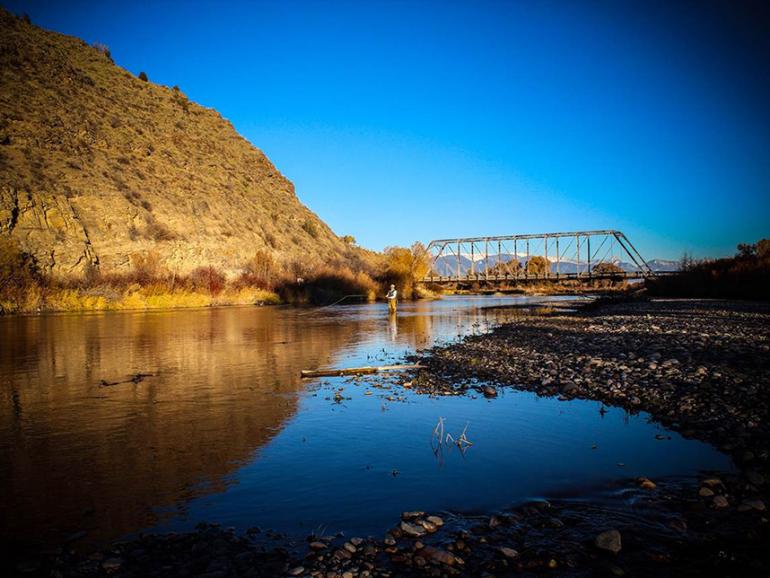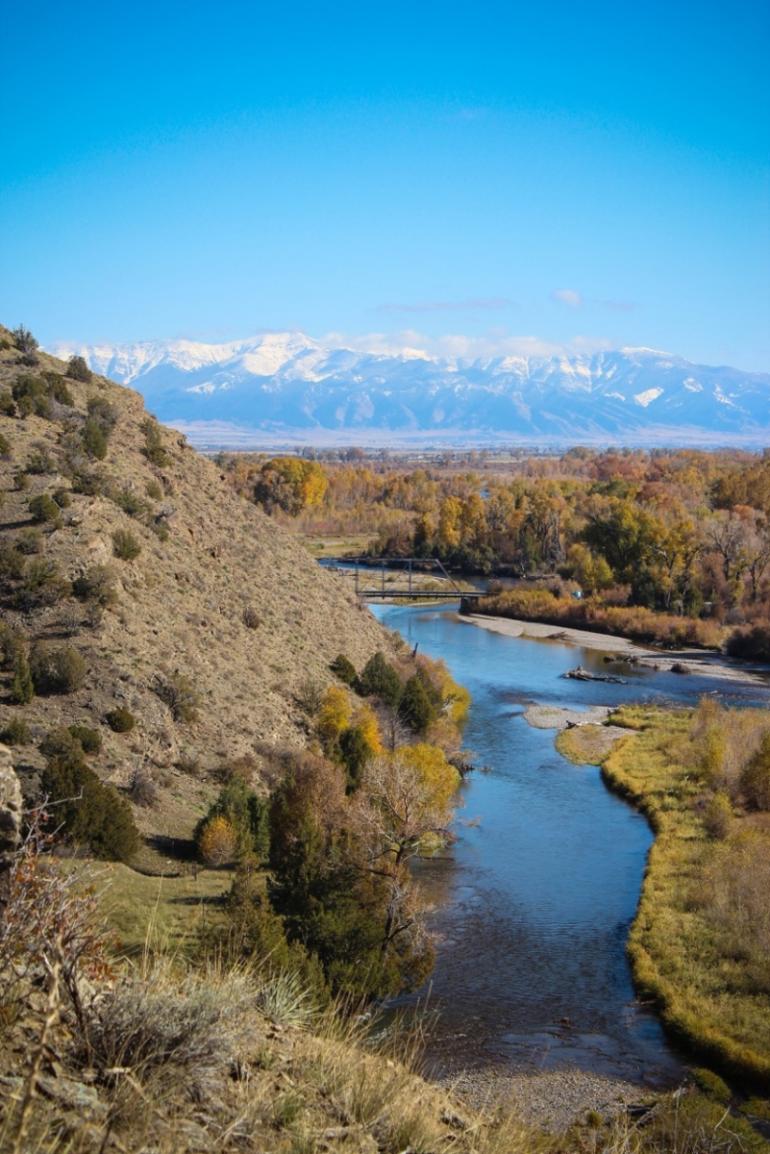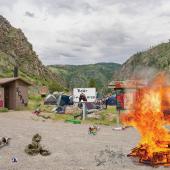Nixing the Nixon
The uncertain fate of a Gallatin River icon.
“The old bridge will be removed.” That’s what Gallatin County Commissioner Don Seifert, along with Commission Chair Steve White, told Outside Bozeman. For groups like the Montana Ghost Town Preservation Society and the Manhattan Rotary Club, this news means an end to their years-long bid to save the old bridge—what they call a “gem on Montana’s landscape.”
“It should be preserved. Once it’s gone, it’s gone forever.” That’s what Montana Ghost Town Preservation Society President Brad O’Grosky told Outside Bozeman. His organization, along with several others around southwest Montana, still have hope that the bridge can be saved. But that hope may be futile, according to the bridge’s project engineer, Kathy Thompson of Stahly Engineering. “I just don’t think they’re going to get the money they need,” she says.
The Nixon is a scenic one-lane overpass that crosses the Gallatin River near Manhattan on Nixon Gulch Road. The bridge, built in 1891, is one of the last Pratt truss overpasses in the state. It’s pin-connected, built to be taken apart, shipped in pieces, and reconstructed at a different location. The Nixon wasn’t moved to its current location until 1923, when it was replaced by a new bridge at the former Central Park community, on the Frontage Road between Belgrade and Manhattan.
The clock is ticking on the historic Nixon Bridge. Preservation groups must come up with $60,000 before the bridge’s removal in late winter 2019—money that will go into a demolition bond, should preservationists fail to repair and support the bridge as time goes on. So far, they have $3,200. Commissioners have been sitting on $750,000 from the state to move forward with construction on the new bridge. They’re worried that if they don’t use the money soon, they could lose it.
Another organization involved in the affair is Montana Fish, Wildlife & Parks (FWP). According to Seifert, “FWP was a player in this whole thing, because the new bridge was going to sit on their fishing access site. Given the way the new bridge will be positioned [diagonal to the river], FWP did a thorough study and saw the need for the old bridge to be removed.” White echoes that, saying, “The bridge that’s there now is causing unnatural obstacles; it wasn’t built for that area, and the hydraulics aren’t natural for that stream.”
It seems that FWP, county commissioners, and Stahly all want the same thing: removal of the Nixon. It’s old, unsafe, and ecologically unsound. Plus, problems surrounding the safety of the bridge have made matters worse as an upscale development grows on the opposite side of the river.
The Nixon Bridge connects a county road north of Manhattan to the Gallatin River Ranch (GRR), a 6,000-acre residential development. The GRR boasts a “world-class equestrian center”; the “pristine,” “authentic,” “rural” community gives private landowners the “comfortable upscale lifestyle [they’ve] dreamed of,” according to GRR’s website. Interestingly, the ranch’s developer—Tom Langel, owner of Amerimont Real Estate—is an outspoken member of the Montana Rotary Club, and an advocate of saving the Nixon.
“It doesn’t get more picturesque than the Nixon,” Langel opines. “My family’s lived north of the river for 25 years, so I drive over the bridge at least twice a day… They don’t make truss bridges like that anymore.” Some 400-plus cars drive back and forth across the bridge every single day, GRR’s 185 (and growing) residents accounting for most of it.
“Some of [GRR’s] residents have complained that firefighting vehicles and construction trucks are too heavy to cross the bridge with its posted 13-ton weight limit,” the Bozeman Daily Chronicle reported in April 2016. And Thompson recently told Outside Bozeman, “The posted weight limit doesn’t allow the bridge to be used by a number of service and construction vehicles.”
In fact, garbage service recently stopped to GRR because the trucks are too heavy. “That’s when [GRR residents] really got stirred up,” White says. Residents of GRR are overwhelmingly in favor of building a new bridge, so much so that they have agreed to pay into a $400,000 Rural Improvement Bond to foot part of the new bridge’s development, according to HOA president John Andrews.
Worse yet, “Wildland fire would not be able to be stopped,” White says, because fire trucks can’t cross the old bridge. White relays a story of one woman who spoke at a commission meeting, who said she rolled down her windows every time she crossed the bridge for fear that it would collapse. The only other way to access property across the bridge is via a 32-mile detour on an unmaintained road.
Still, preservationists plod along. O’Grosky’s plan to save the Nixon involves the city of Manhattan. “If Manhattan would take ownership of the bridge, I think they would resolve the issue,” he says. “I know that’s always been their plan. Engineers won’t construct the new bridge until the winter, so the existing bridge would remain until the new bridge is completed. We still have time.”
Eleanor Mest is the former mayor of Manhattan and part of the preservation effort. She supports O’Grosky’s plan. “I hope the mayor of Manhattan would try to convince commissioners to take ownership of the bridge,” she says, “but I also know they’ve given us long enough to come up with a solution. And FWP doesn’t want the bridge there, so that’s another shot against us.”
FWP’s Ray Heagney says that keeping the old bridge constricts the river; that from a stream-function point of view, keeping the old bridge doesn’t make sense. In addition, if the two bridges were to remain, recreational access to the waters under the bridge would disappear.
“If they were to leave that old bridge in place,” Heagney says, “access would all be under a road.” He says there isn’t a lot of parking or boat-launch room as it is, and if there were a second bridge, it would have to go right over the fishing access point. There simply is no room for two bridges in proximity from either an ecological or recreational perspective.
However, O’Grosky isn’t too worried. “The bridge has been there for 100 years already,” he says, “so I don’t see what the problem is.”
In response, FWP’s Travis Horton explains, “That bridge has constricted the river for 100 years. If you look at an aerial map, you can see the [unnatural] changes of the channel; the river’s trying to go south around the bridge toward Manhattan. It’s trying to cut around the bridge because it’s too narrow there, and you can see there’s even erosion upstream, too.” Horton says they have been placing rocks and riprap to protect the road and the river, but the bank is eroding even after efforts at stabilization.
“[Riprap] is just a band-aid,” Horton says. “The old bridge is constricting the stream; the new bridge needs to have a bigger span to ease water constriction.”
The commissioners have taken into account recommendations from FWP, Stahly Engineering, and preservation groups, but say they don’t see any way around demolishing the bridge. However, we at Outside Bozeman see two scenarios that could please all parties. The first is, instead of building a concrete-slab eyesore of a new bridge, replicate the old Nixon onto the new bridge to maintain historical integrity. A few steel trusses—perhaps even pieces from the Nixon—shouldn’t be too hard to incorporate into a bridge design.
But the commissioners say that’s not an option. “I don’t believe taxpayers are interested in paying for that,” Seifert says. “Those costs escalate rapidly and we’re respectful of taxpayer dollars. We’re looking for a bridge that’s safe and can get service vehicles across and we’re pretty utilitarian.” But does the money have to come from county taxpayers? Perhaps if preservationists can’t come up with enough to save the old bridge, they can still maintain a modicum of historical integrity. They could put what they’ve earned toward aesthetics.
The second scenario is one put forth by Horton: “Driving up to that bridge, on the right-hand side, there’s a creek that parallels the road, and it moves into a slough right at the fishing-access piece. If you want to save the historical integrity, move the old bridge over the tributary. Then we could move the fishing access, with better parking upstream. They’d just pick it up with a crane and move it; it’d be fairly inexpensive.”
Both good ideas, we think. And at the end of the day, the case for the Nixon Bridge’s removal is by and large a good one. When the Nixon moved to its current location, the bridge was too short from the start. “In 1923, builders didn’t have a choice,” White explains. “They just ran a tape measure across the bridge and said, ‘Well, we’re too short. We’ll put up some riprap to keep it standing.’ Ninety-five years ago? No problem. Today? No way.”
Southwest Montana continues to grow, and some historical structures inevitably need replacing. But if the county can make necessary changes with character and historical integrity at heart, we can hold onto the old places we love, little by little; all we need is imagination and compassion. The rest will flow naturally.














